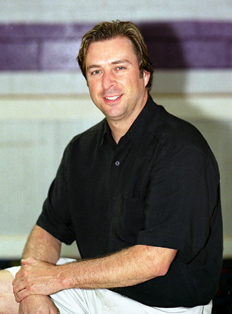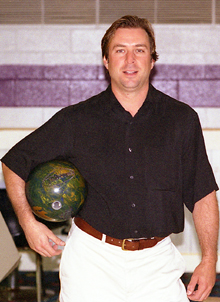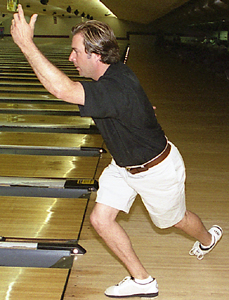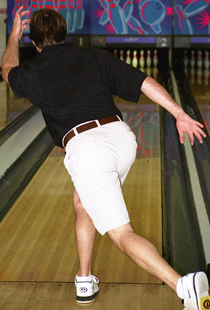Do you find people treating or perceiving you differently now?
I honestly don't know if a lot of people even know. Obviously, I had great support from my family and friends and so forth, but I don't know if the league bowlers really even know about it or necessarily care about it. And I think that's one of the focal points of the tour, and that's not necessarily good.
To me, one way or the other, it really doesn't make a difference. Obviously, I appreciate the kind words, but that's okay. But I do think there is a problem in the fact that the people don't know because it's not necessarily that important to them. And I think that's something that the new ownership is trying to change, which is a very difficult task.

When you are getting ready to throw that first practice ball at an event, what are you looking for (trying to see) on the lane?
The thing that is very difficult is that you can't see it, as we know. You're looking for your ball to roll a certain way, and I know that sounds silly. I try not to make analogies, but it's almost like getting a true roll on a putting surface, if you're going to practice golf and your putting stroke.
A bowling ball has to roll a certain way not just to hit the pocket; it has to roll to carry. So the main focus other than what you are trying to do physically is you're first trying to judge how much oil is on the front part of the lane and the length of it. Laterally, what is to the inside of your target or outside of your target, and by moving across the lane, which is the key, you're not only trying to find the best way to the pocket, but the best way to carry and by moving pairs.
So you're really looking for a ball to roll a certain way, and then by adjusting your speed and the type of spin or rotation that you apply to it, which will then hopefully give you potential area on the lane and/or better pin carry. But you also have to judge the scoring pace, and that can't be done obviously on one ball. That's once you see the tournament start.
But more than anything, what I was told by somebody who was very helpful was Rick Benoit from Brunswick. He says that what you're looking for is you're trying to read more of the front part of the lane—how much oil is there, as you bowl on it, how will it change, will it carry down, will it start to hook early or will it tighten up down the back-end, what type of surface are you bowling on. From there, you're simply trying to see the ball roll in a true manner, so that when you miss, you don't leave the 2-8-10 or the 3-7-9.
Can local players prepare themselves for today's tour away from the tour?
You could, but it would be very difficult because [the PBA has] five patterns currently. It would take a lot of effort and a lot of money.
What is the current situation with your pro shop?
I'm slowly trying to get out. I'm looking to move on.

If you had bowled and failed in the Tour Trials, what would you have done?
I was talking to a close friend about this before when I wanted to bowl this segment. I said, Look, I'm going to bowl till March. If I don't make it, I'm done. Done-completely done. I'm not going to go to the Tour Trials. I'm not going to bowl regionals, I'm not going to do anything. I may bowl some leagues or some local stuff. And I felt that a lot of players who did not make the cut-who did not make the top 50. Right after the tour was over, they said they weren't going to bowl the Tour Trials. I looked at the list, and a lot of players are bowling the Tour Trials.
I have a feeling I would have bowled the Tour Trials because I think it's an ego thing. I think for me, it would be, I've bowled all that time out on tour, and here I have to go attempt to prove myself, and I don't want to do it anymore. I'm tired. The reality is that you tried, you didn't make it, move on. But I probably would have been at that Tour Trials.
However, I think if I would have bowled the Tour Trials and not make it, I think a dose of reality would have hit me right in the face again, saying enough is enough, and it's time to move on.
I don't know if I would have continued to attempt to bowl the Tour Trials because it is once a year. I honestly can tell you, I would not be chasing the regional program, and I'm not going to go rabbit.
I understand why they're doing it, but I also understand I'm 37 and this is designed maybe for the kid coming out of college, the megabuck bowler, and he wants to go pursue it, I totally agree with it. Enough's enough for me—this is ridiculous. You're chasing your tail.
If I had I bowled the Tour Trials and didn't make it, I would have stepped back in some capacity and really tried to take a look at what's going on.
What are your thoughts about the future of the PBA?
I don't know. There's so much skepticism on whether this is going to work or not. I think about the format, and I understand why it's done, I don't know how the bowling spectator is going to accept it—I don't know if they'll accept it or not. However, I don't know if that necessarily matters to the PBA. Obviously, it's about money, and if they can sell, and the players can somehow promote themselves, and with the help of the PBA, obviously, and make that show profitable, it will work. It's all about TV. That's my impression; that's what I'm getting.
The format, the reason it has changed, they're trying to consolidate things. But it's all about, from what I can see, Mr. Miller and that group selling and promoting that show to make it viable, to make it a moneymaker.
Because you can get only so many spectators in a bowling center, you can't make it off of the gate—it's impossible. They realize that because they're sharp, so that show is the vehicle. And that show, depending on the players, the advertisers, from, for example, the team concept of Bayer, Storm, Geico, Banquet Foods, and Pepsi—those are all things that they're trying to create some visibility for those players, and I think we may end up looking like maybe NASCAR. We may be billboards out there.
The show is what it's all about.
* * * *
Most helpful individual for your game on tour: Rick Benoit of Brunswick. He emphasized the fact that I need to focus on my ball roll, what I’m trying to achieve, and not necessarily worry so much about what I’m doing physically. … He’s the reason I made it.
Closest buddy on tour: Eric Forkel. We’ve been rooming together, grinding together. … We’ve been good friends for a long time.

Player whose success surprised you the most this season: Steve Jaros made a change to his game that obviously beneficial. … He really stepped it up and had a great year.
Player whose failure surprised you the most: Steve Hoskins because of unfortunate circumstances. He had a lot of stuff going on in his life.
Player who most gets your attention: I’d say Mika K[oivuniemi] because of his reputation of pounding left-handers.
Player most fun to spend time with: Mike Miller by far. He may be the funniest individual I ever met in my life.
Young player I guarantee will become a star: Chris Johnson [of Garland, Tex.], the PBA Rookie of the Year, and Ronnie Russell, an exceptional bowler and person. I like his game, I like his attitude. I like him.
Grade for ESPN's Dave Ryan-Randy Pedersen broadcast team: I’ll give ‘em a B-plus. I can’t give out an A, and I don’t watch the shows that much.
Lowest moment during the season: After Indianapolis, with one tournament to go.
Bowler's aid I use most: Tape. I go through tape like your old friend, Arnie Goldman!
Strongest aspect of my game: Ability to be competitive on any lane condition.
Aspect most in need of improvement: Lack of ability to recognize what to do and then taking the chance that it may not be the correct thing but doing it anyway just to check it out and confirming in my head that I was right or wrong.
Women who'd succeed most on PBA Tour: Michelle Feldman sticks out in my mind because I just think that the way she rolls the ball, and especially if we were qualifying. If we were qualifying, I think she would have the best opportunity because she can play anywhere on the lane that a man can. She gets so much power on the ball that she’s phenomenal. She’s unbelievable. … If there was a lady who was able to get into this current format and bowl match play, Carolyn Dorin-Ballard is maybe one of the best bowlers I’ve ever seen as far as the ability to make a shot when she needs it. She is tenacious. She is an excellent bowler.

Most memorable match this season: Of the three matches in Detroit, it was by far the Mika match.
One thing I learned in 2003-2004 season: Under this current regime, every pin counted.
Major difference between tours of 1994 and 2004: The competitiveness of the tour is much stronger today than it was then. I think the younger players—collegiates, Team USA, amateur bowlers—I think there’s a crop of those guys that are extremely talented, and they have as much qualifications to bowl on tour as some of the guys that have been out there 10 years. They were professionals as amateurs, basically, and they’re just phenomenal. As a group, the tour is a much more difficult place to actually make a living.
Main competitors locally: I don’t bowl that much locally, but I do know there are some bowlers who are bowling particularly well, and I have a lot of respect for them. And the fact that they’re going out and actually expanding their bowling in regionals to potentially go out on tour—Buddy Blackmore, Bobby Hall [II], Kenny Lowe, and, obviously, Jimmy Lewis.
Next goal: To make that Top 40.
— Bob Cosgrove